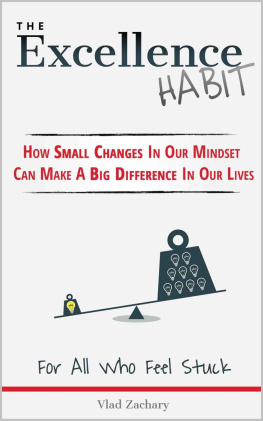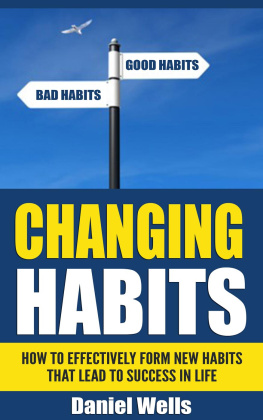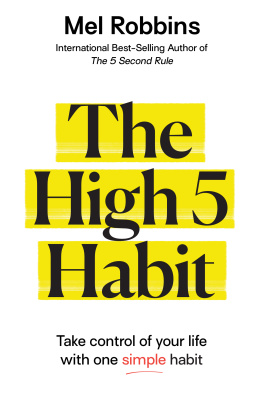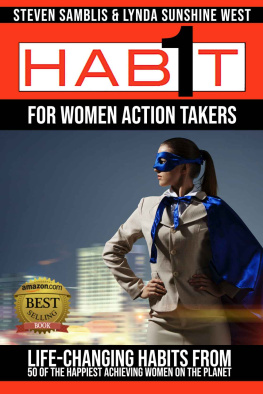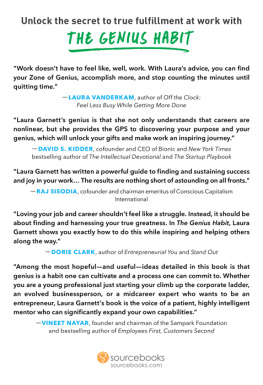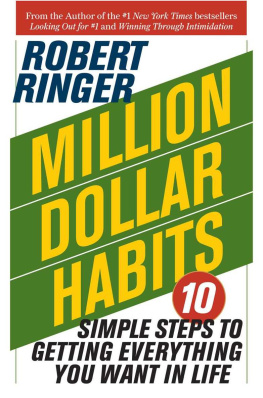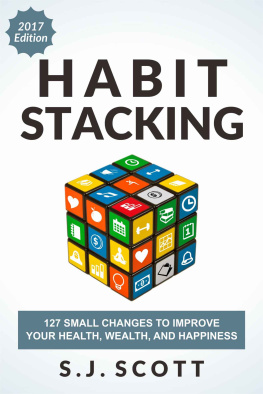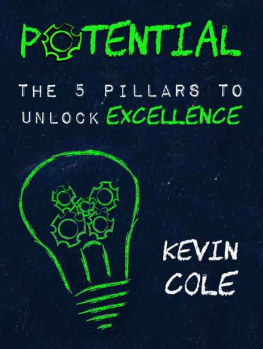How Small Changes in Our Mindset Can Make a Big Difference in Our Lives
Vlad Zachary
Coffee Stain Publications
The Excellence Habit
How Small Changes in Our Mindset Can Make a Big Difference in Our Lives
For All Who Feel Stuck
Copyright 2015 Vlad Zachary
Cover design courtesy of PLC
All Rights Reserved
For information about special discounts for bulk purchases, please visit http://vladzachary.com/
ISBN-13: 978-1519256614
ISBN-10: 1519256612
Library of Congress Control Number: 2015919961
Printed in the United States of America
To Martin and Amelia
And to my wife, Tatyana
Thank you
We are what we repeatedly do. Excellence, then, is not an act, but a habit.
Aristotle
As paraphrased by Will Durant in his book The Story of Philosophy: The Lives and Opinions of the Worlds Greatest Philosophers.
It is not the mountain we conquer, but ourselves.
Edmund Hillary
First man on Everest
Table of Contents
Excellenceology
One
The Three Rules of Excellence:
The Iceberg Principle
The Law of Not Selling Out
The Journey Mindset
Two
The Tennis Ball Effect
The Broken Windows of Our Soul
Wiping Out Our Inner Graffiti
Changing Our Bodies to Change Our Minds
Three
Rewriting Our Story
Addicted to Excellence
The N-Effect
Four
Move Your Own Cheese for Organizations
Design, Build, Launch, Survive!
People Matters
Five
Drivers of Our Behavior and Resistance
Trouble and Resistance
Resistance and Exile
The I Could Have Been Somebody Regret
Instead of Appendix
Tools and Skills For Excellence in Your Career
Starting Point - The Personality Type
The 7 Components of Perception
Build your brand, protect your name: Why is perception management important?
The Power Of Perception And Personality Types
The 5 Steps to Effective Perception Management
Leveraging the 4 Principal Temperament Types
How to Survive and Thrive at Office Politics
Acknowledgements
Excellenceology
Most of us have two lives. The first one is the life we actually live, and the second is the imagined life where we achieve all the success we dream about. Some build a bridge between these two lives. Here are three short stories of success that seem to have very little in common.
For Amy Cuddy, the Excellence Habit came after a bad car accident. At age nineteen she was thrown out of a vehicle and rolled several times. She woke up in the hospital with a severe head injury. As a result her IQ had dropped by two standard deviations, and she had been withdrawn from college. This was very traumatic for Amy, because she identified with being very smart. She had been called gifted as a child. So she tried to go back, and they told her she was not going to be able to finish college! There are other things you can do, she was told, but college was not going to work out. She really struggled with that. When her core identity was taken from her, it was the worst possible feeling.
As Amy felt overwhelmingly helpless, the one thing she could do was work. So she worked, and worked, and worked, and got a lucky break and back into college. Then she worked more, and, eventually, Amy graduated from college. It took her four years longer than her peers. According to her Wikipedia page today, Amy Cuddy is an American social psychologist known for her research on stereotyping and discrimination, emotions, power, nonverbal behavior, and the effects of social stimuli on hormone levels. She teaches at Harvard, and the video of her 2012 TED talk on body language has the second highest number of all-time views on TED.com. Amys story is extraordinary because when faced with seemingly insurmountable obstacles, she chose to follow her mission. To use the popular metaphor from the book Who Moved My Cheese, she chose to move her own cheese. Amy chose to keep working when there was no realistic hope she could get back what she had lost. Even when she believed she didnt belong in academia, Amy kept going.
For Jia Jiang, the path to the Excellence Habit started with a dream to become the next Bill Gates. In 2012, four days before his first child was born, Jiang, thirty-one, quit his corporate job at Dell. He started working full-time on his start-up. Jia had an agreement with his wife that she would support the family for six months. After that, he needed to get another job. About five months later, a major investor rejected Jias business. This really crushed the young CEO. Jia felt like he was dumped. He hated the rejection, and he hated how much it hurt. So, Jia decided to study rejection to learn how to withstand it better. He devised a plan to get rejection from strangers so he could gradually toughen up. Jia felt he needed to acquire this skill in order to be successful as an entrepreneur. To his surprise, instead of rejecting him, many of the odd requests he made of total strangers were accepted. For instance, he got to drive a police car, fly a small airplane, make a PA announcement at Costco, and play soccer in a random homeowners backyard.
Time and again, people said yes to Jias unusual requests. He began making videos of his encounters and documented the surprising reactions. His plan was to get a no one hundred times in one hundred days to beat his fear of rejection. In November 2012, on his third day, he asked a Krispy Kreme manager to make him a set of doughnuts in the shape and colors of the Olympic Rings in fifteen minutes. His plan was to get another rejection. Instead, Jia got the doughnuts. The video of his failed attempt to get a no has more than five million views. As of 2015, Jia Jiang is a successful entrepreneur, published author, and public speaker. His story is inspiring because Jia faced his worst fears, took action to conquer them, and learned from the experience. Somewhere along the way of making his awkward requests, Jia gained authentic confidence, detached himself from the results, and turned rejection into an opportunity.
For Marco Morawec, the Excellence Habit became a key component of his new venture strategy. In 2013, together with fellow coder Ken Mazaika, Marco decided to teach beginners how to code a complete web app in one weekend. It was a bold idea, never done before. The two engineers called it The Firehose Weekend. Their ambition, as declared on their site, was to teach what matters and to condense at least five times the amount of comparable self-guided learning into each session. The focus was on the most important skills needed to build and deploy high quality web applications.
After deciding on the idea, Marco and Ken started coding the website for their project. Then, it hit them. What if nobody wanted to pay for this kind of breakneck fast learning? All their work on coding the website and preparing a curriculum would be wasted. Marco realized something else, too. As soon as they agreed on the idea, they went for what they knew how to do coding. The idea to ask strangers to pay them for training was scary. This is when Marco realized that to succeed, they needed to operate outside their comfort zone. The two partners agreed on two principles. First, whatever they offered had to have a price. Second, they needed to do things that felt scary. So they stopped coding a new site and set up an online form with a buy button. The price of admission was $200, with an early-bird special of $100. Although it scared them, Marco and Ken did the logical thing. The best way to know if someone would buy their course was to offer it for sale. When their first offering was fully subscribed in a couple of weeks, they were thrilled and terrified at the same time. They had a short time to figure out a curriculum and a place to teach. The first Firehose Weekend was a success. Three years later, Marco and Ken have run events from Boston and New York to Honolulu. Marcos story is enlightening because he realized that success will be outside his comfort zone and had the courage to act upon this. A life worth living is spent outside your comfort zone! became Marcos favorite sentence and a maxim he strives to apply relentlessly to this day.

